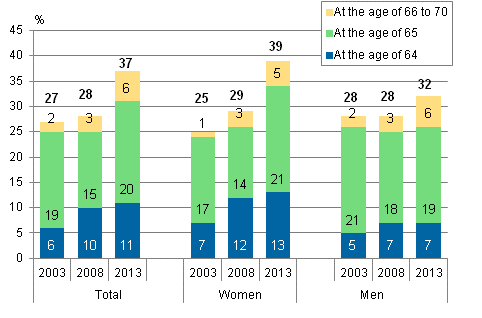Published: 9 April 2014
Employees' estimates about their age of retirement have risen considerably
Employees' estimates about the age at which they will retire have risen considerably in five years. In 2013, nearly two out of five (37%) employees aged over 50 thought they would retire at the age of 64 or later, while the corresponding share was 28 per cent in 2008. These derive from the preliminary data of Statistics Finland's Quality of Work Life Survey for 2013.
Women believe they will continue their work career until aged over 63 more often (39%) than men (32%), and women's willingness to continue at work has grown more than men's in five years. The share of those female employees aged over 50 who think they will work at least until they are 65 has risen particularly much.
Estimated retirement age 64 or more

Employees aged over 50, Quality of Work Life Survey 2003, 2008 and 2013.
Education and occupational status are strongly connected to employees' willingness to continue their working career over the age of 63. Thirty-one per cent of employees with basic education thought they would retire when aged over 63, but the figure was 46 per cent for those having tertiary level qualifications. Correspondingly, 61 per cent of upper-level employees in management positions are going to retire aged over 63, but this share is 18 per cent for manufacturing workers. The possibilities to continue one's career are quite evidently worse for those doing heavy manufacturing work than for the highly educated or usually for those belonging to upper-level employees.
Thoughts about continuing are more common in the public sector than in the private sector. In the public sector, the educational level of employees is certainly higher than in the private sector, but employers' age policy and the certainty of the employment relationship also have an additional effect. In the central government sector (universities excluded), 55 per cent of employees are willing to continue working, in the local government sector, 48 per cent and in the private sector, 29 per cent.
Super accumulation has an effect on willingness to continue
From 2005, the pension of employees aged over 63 has grown with a higher percentage than that of employees younger than this. In the Quality of Work Life Survey, it has been inquired whether this so-called super accumulation increases employees' willingness to carry on at work after they are 63. The question was already asked preliminarily in 2003, when the idea was to assess the future effects of the pension review in 2005.
In 2013, 43 per cent of all employees aged over 50 admitted that super accumulation increases their willingness to continue in working life after the age of 63. There is no difference between genders in this respect. The share has risen by over ten percentage points from 2008, and still more compared to 2003: from 26 to 43 per cent. This substantial growth is probably explained by that the meaning of super accumulation has become more widely known in ten years and the willingness to continue at work longer has increased generally as well.
However, it is not always considered possible to continue at work. In the Quality of Work Life Survey in autumn 2013, 11 per cent of employees aged over 50 reckoned their health would not allow them to continue to work after the age of 63 regardless of the fact that they would personally like to carry on working. In addition, three per cent thought that their employer would not want them to continue although they would want to. There is no difference in this respect either by gender.
People want to work after retirement as well
The willingness to continue working when retired has also become more widespread. In 2013, as many as 70 per cent of employees aged over 50 said they could consider working during retirement either full-time, part-time or temporarily, while in 2008 this share was 54 per cent. Preparedness for working when retired is slightly more general among men (74%) than women (70%). It is most common for upper-level employees (82%) and least common for manufacturing workers (61%).
Is staying on at work promoted at workplaces?
Employees think that workplaces now encourage ageing people to stay on at work slightly more often than five or ten years ago. Nearly every third (30%) employee thought in 2013 that ageing people at his or her present workplace are encouraged to stay on at work longer than at present either strongly or to some extent. In 2008, the corresponding share was 29 per cent and in 2003, it was 22 per cent. At workplaces where the number of employees has increased in recent years, 33 per cent of employees felt that ageing people are encouraged to stay on at work at least to some degree. In those workplaces where the number of employees has clearly reduced, the respective share was only 19 per cent.
The Quality of Work Life Survey offers a good instrument for studying employees' retirement intentions. The data of the Quality of Work Life Survey are sufficiently large, the response rate is good, the questions have been kept as similar as possible and the survey is made with a reliable personal interview method.
Source: Quality of work life survey , Statistics Finland
Inquiries: Hanna Sutela 09 1734 2907, Anna-Maija Lehto 09 1734 3223, tyoolotutkimusi@stat.fi
Director in charge: Riitta Harala
Publication in pdf-format (187.8 kB)
- Tables
-
Tables in databases
Pick the data you need into tables, view the data as graphs, or download the data for your use.
Updated 9.4.2014
Official Statistics of Finland (OSF):
Quality of work life [e-publication].
ISSN=2342-2890. 01 2013. Helsinki: Statistics Finland [referred: 20.12.2025].
Access method: http://stat.fi/til/tyoolot/2013/01/tyoolot_2013_01_2014-04-09_tie_001_en.html

